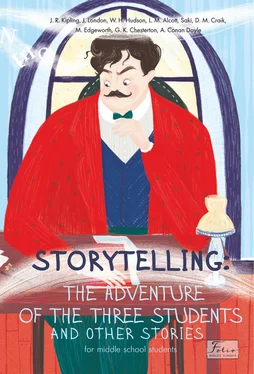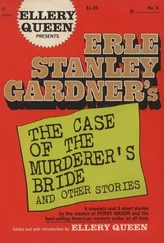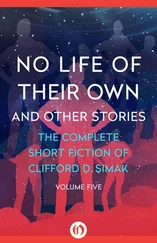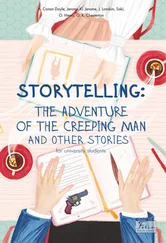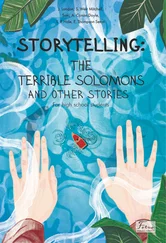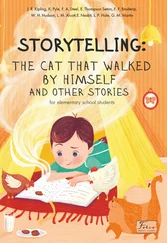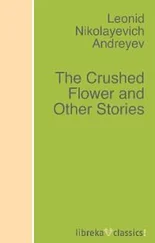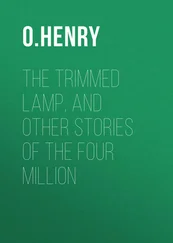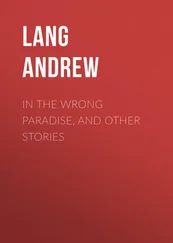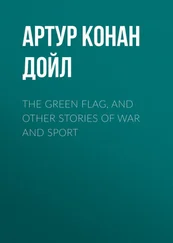Сборник
Storytelling. The adventure of the three students and other stories
© Yu. Belochkina, compiling, 2021
© O. Huhalova-Mieshkova, graphic artist, 2021
© Folio Publishing House, brand series, 2020
by Saki
Tom Yorkfield had always regarded his half-brother, Laurence, with a lazy instinct of dislike, toned down, as years went on, to a tolerant feeling of indifference. There was nothing very tangible to dislike him for; he was just a blood-relation, with whom Tom had no single taste or interest in common, and with whom, at the same time, he had had no occasion for quarrel. Laurence had left the farm early in life, and had lived for a few years on a small sum of money left him by his mother; he had taken up painting as a profession, and was reported to be doing fairly well at it, well enough, at any rate, to keep body and soul together. He specialised in painting animals, and he was successful in finding a certain number of people to buy his pictures. Tom felt a comforting sense of assured superiority in contrasting his position with that of his half-brother; Laurence was an artist-chap, just that and nothing more, though you might make it sound more important by calling him an animal painter; Tom was a farmer, not in a very big way, it was true, but the Helsery farm had been in the family for some generations, and it had a good reputation for the stock raised on it. Tom had done his best, with the little capital at his command, to maintain and improve the standard of his small herd of cattle, and in Clover Fairy he had bred a bull which was something rather better than any that his immediate neighbours could show. It would not have made a sensation in the judging-ring at an important cattle show, but it was as vigorous, shapely, and healthy a young animal as any small practical farmer could wish to possess. At the King’s Head on market days Clover Fairy was very highly spoken of, and Yorkfield used to declare that he would not part with him for a hundred pounds; a hundred pounds is a lot of money in the small farming line, and probably anything over eighty would have tempted him.
It was with some especial pleasure that Tom took advantage of one of Laurence’s rare visits to the farm to lead him down to the enclosure where Clover Fairy kept solitary state – the grass widower of a grazing harem. Tom felt some of his old dislike for his half-brother reviving; the artist was becoming more languid in his manner, more unsuitably turned-out in attire, and he seemed inclined to impart a slightly patronising tone to his conversation. He took no heed of a flourishing potato crop, but waxed enthusiastic over a clump of yellow-flowering weed that stood in a corner by a gateway, which was rather galling to the owner of a really very well weeded farm; again, when he might have been duly complimentary about a group of fat, black-faced lambs, that simply cried aloud for admiration, he became eloquent over the foliage tints of an oak copse on the hill opposite. But now he was being taken to inspect the crowning pride and glory of Helsery; however grudging he might be in his praises, however backward and niggardly with his congratulations, he would have to see and acknowledge the many excellences of that redoubtable animal. Some weeks ago, while on a business journey to Taunton, Tom had been invited by his half-brother to visit a studio in that town, where Laurence was exhibiting one of his pictures, a large canvas representing a bull standing knee-deep in some marshy ground; it had been good of its kind, no doubt, and Laurence had seemed inordinately pleased with it; “the best thing I’ve done yet,” he had said over and over again, and Tom had generously agreed that it was fairly life-like. Now, the man of pigments was going to be shown a real picture, a living model of strength and comeliness, a thing to feast the eyes on, a picture that exhibited new pose and action with every shifting minute, instead of standing glued into one unvarying attitude between the four walls of a frame. Tom unfastened a stout wooden door and led the way into a straw-bedded yard.
“Is he quiet?” asked the artist, as a young bull with a curly red coat came inquiringly towards them.
“He’s playful at times,” said Tom, leaving his half-brother to wonder whether the bull’s ideas of play were of the catch-as-catch-can order. Laurence made one or two perfunctory comments on the animal’s appearance and asked a question or so as to his age and such-like details; then he coolly turned the talk into another channel.
“Do you remember the picture I showed you at Taunton?” he asked.
“Yes,” grunted Tom; “a white-faced bull standing in some slush. Don’t admire those Herefords much myself; bulky-looking brutes, don’t seem to have much life in them. Daresay they’re easier to paint that way; now, this young beggar is on the move all the time, aren’t you, Fairy?”
“I’ve sold that picture,” said Laurence, with considerable complacency in his voice.
“Have you?” said Tom; “glad to hear it, I’m sure. Hope you’re pleased with what you’ve got for it.”
“I got three hundred pounds for it,” said Laurence.
Tom turned towards him with a slowly rising flush of anger in his face. Three hundred pounds! Under the most favourable market conditions that he could imagine his prized Clover Fairy would hardly fetch a hundred, yet here was a piece of varnished canvas, painted by his half-brother, selling for three times that sum. It was a cruel insult that went home with all the more force because it emphasised the triumph of the patronising, self-satisfied Laurence. The young farmer had meant to put his relative just a little out of conceit with himself by displaying the jewel of his possessions, and now the tables were turned, and his valued beast was made to look cheap and insignificant beside the price paid for a mere picture. It was so monstrously unjust; the painting would never be anything more than a dexterous piece of counterfeit life, while Clover Fairy was the real thing, a monarch in his little world, a personality in the countryside. After he was dead, even, he would still be something of a personality; his descendants would graze in those valley meadows and hillside pastures, they would fill stall and byre and milking-shed, their good red coats would speckle the landscape and crowd the market-place; men would note a promising heifer or a well-proportioned steer, and say: “Ah, that one comes of good old Clover Fairy’s stock.” All that time the picture would be hanging, lifeless and unchanging, beneath its dust and varnish, a chattel that ceased to mean anything if you chose to turn it with its back to the wall. These thoughts chased themselves angrily through Tom Yorkfield’s mind, but he could not put them into words. When he gave tongue to his feelings he put matters bluntly and harshly.
“Some soft-witted fools may like to throw away three hundred pounds on a bit of paintwork; can’t say as I envy them their taste. I’d rather have the real thing than a picture of it.”
He nodded towards the young bull, that was alternately staring at them with nose held high and lowering its horns with a half-playful, half-impatient shake of the head.
Laurence laughed a laugh of irritating, indulgent amusement.
“I don’t think the purchaser of my bit of paintwork, as you call it, need worry about having thrown his money away. As I get to be better known and recognised my pictures will go up in value. That particular one will probably fetch four hundred in a sale-room five or six years hence; pictures aren’t a bad investment if you know enough to pick out the work of the right men. Now you can’t say your precious bull is going to get more valuable the longer you keep him; he’ll have his little day, and then, if you go on keeping him, he’ll come down at last to a few shillingsworth of hoofs and hide, just at a time, perhaps, when my bull is being bought for a big sum for some important picture gallery.”
Читать дальше
